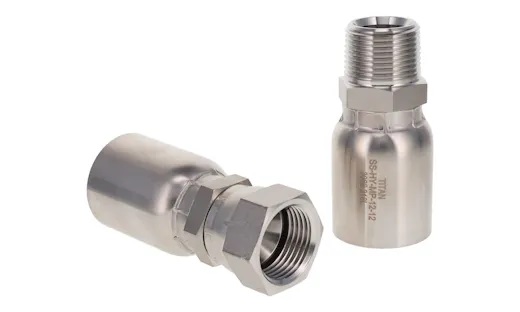Introduction
Hydraulic systems depend on strong and reliable connections between hoses and equipment. The end fittings of hydraulic hoses are essential in ensuring these connections are secure, especially under high pressure, preventing leaks or failures. This blog will take a closer look at six common types of hydraulic hose end fittings: crimp fittings, hose barbs, push-lock fittings, quick connects, compression fittings, and reusable fittings. We'll explore their design, advantages, and typical applications to help you make an informed choice for your specific needs.
1. Crimp Fittings
Design: Crimp fittings are permanently attached by using a crimping machine to compress the fitting around the hose. This creates a tight, durable seal. These fittings can be made from various materials such as stainless steel, brass, and other alloys.
Applications: Due to their strength and leak resistance, crimp fittings are ideal for high-pressure environments like manufacturing, automotive, and heavy machinery. They're best suited for applications where frequent disconnection is not required.
Benefits: Crimp fittings offer a strong, long-lasting connection that minimizes the risk of leakage. They are also available in many sizes and styles, making them adaptable to a wide range of systems.
Shop Crimp Fittings
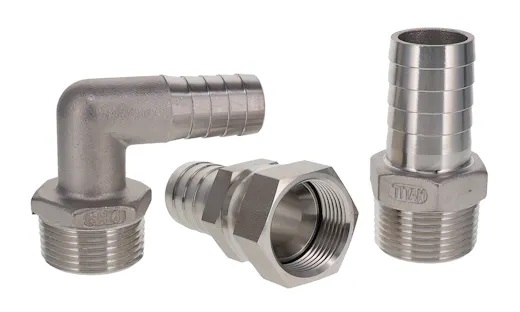
2. Hose Barbs
Design: Hose barbs feature a ridged stem that fits into the hose. A clamp is usually used to hold the hose in place. Installation doesn’t require special tools, which makes them great for quick repairs on-site.
Applications: These are commonly used in low to medium pressure systems such as residential water lines, workshop air hoses, and agricultural fluid transfer.
Benefits: Hose barbs are simple, cost-effective, and easy to install without the need for complicated tools or machinery.
Shop Hose Barbs
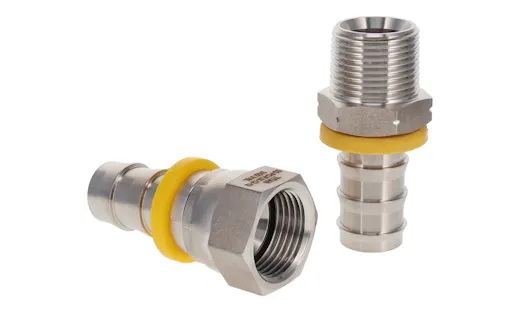
3. Push-Lock Barbs
Design: Push-lock barbs are designed for tool-free installation. The hose simply slides onto the fitting and locks in place thanks to an internal gripping ring that holds it securely.
Applications: Ideal for low-pressure hydraulic and pneumatic systems, including automotive air systems and industrial water lines where quick assembly is needed.
Benefits: These fittings save time and labor with their easy installation. They also provide a clean appearance and are perfect for systems that change frequently.
Shop Push-Lock Barbs
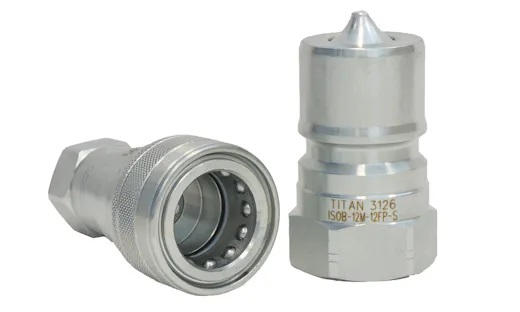
4. Quick Connects
Design: Quick connect fittings allow for fast, tool-free connection and disconnection through a push-pull mechanism. They typically include male and female parts that lock together securely.
Applications: Commonly used in systems requiring frequent hose changes, such as construction and agricultural machinery, as well as chemical plants handling different fluids.
Benefits: Quick connects reduce downtime and minimize fluid loss during disconnection, making them ideal for handling hazardous or expensive substances.
Shop Quick Connects
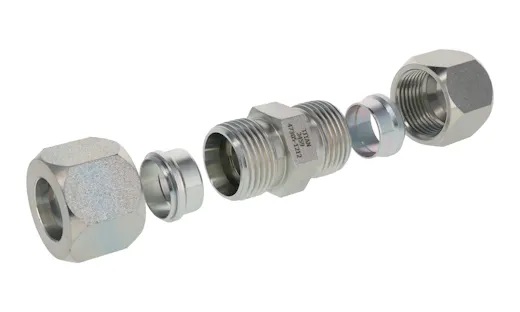
5. Compression Fittings
Design: Compression fittings use a nut and ferrule to create a tight seal when tightened. No flaring of the hose is needed, making them simple to assemble.
Applications: Suitable for medium-pressure systems like fuel lines and refrigeration units. They’re favored for clean, easy-to-disassemble setups.
Benefits: Compression fittings are highly leak-proof and don’t require special tools. They’re durable and ideal for systems that need regular maintenance.
Shop Compression Fittings

6. Reusable Hose Fittings
Design: Reusable fittings are field-attachable, allowing for easy assembly and disassembly without special tools. They consist of a body, a socket, and sometimes a nipple that compresses the hose.
Applications: Perfect for emergency repairs and situations where hoses need to be reconfigured often. Popular in marine, construction, and remote locations where crimping tools aren't practical.
Benefits: These fittings are flexible, cost-effective, and eco-friendly. They reduce downtime and eliminate the need for expensive equipment while promoting reuse and sustainability.
Shop Reusable Hose Fittings
Conclusion
Selecting the right hydraulic hose end fitting is key to ensuring the performance, safety, and reliability of your system. Each type of fitting has its own unique purpose and benefits. Whether you need a permanent connection, quick access, or flexibility, understanding these options helps you choose the best fit for your application.
Q & A
Q1: What are hydraulic hose end fittings used for?
A1: Hydraulic hose end fittings connect hoses to components like pumps, valves, and cylinders. They ensure secure, leak-free connections capable of handling high pressure and tough conditions.
Q2: How do you choose the right hydraulic hose end fitting?
A2: Choosing the right fitting depends on several factors: pressure requirements, compatibility with the hose and fluid, environmental conditions, and the specific application needs such as vibration and mechanical loads.
Q3: Can hydraulic hose end fittings be reused?
A3: Yes, some fittings like reusable or field-attachable ones can be reused. However, crimp fittings are permanently attached and cannot be reused once removed.
Q4: What is the difference between crimp and reusable fittings?
A4: Crimp fittings are permanently fixed using a crimping machine, while reusable fittings can be manually assembled and disassembled with hand tools, making them ideal for repeated use.
Q5: Why would you use a quick connect fitting in a hydraulic system?
A5: Quick connect fittings are useful when frequent disconnections and reconnections are needed without tools. They help reduce downtime and prevent fluid loss during maintenance or hose changes.
Variable Spring Hangers And Supports
Variable Spring Hangers And Supports,Pipe Fitting Hanger,Variable Spring Hangers,Pipe Fitting Hanger Bracket
Simcan Industrial Equipment Co.,Ltd. , https://www.simcanindustry.com

